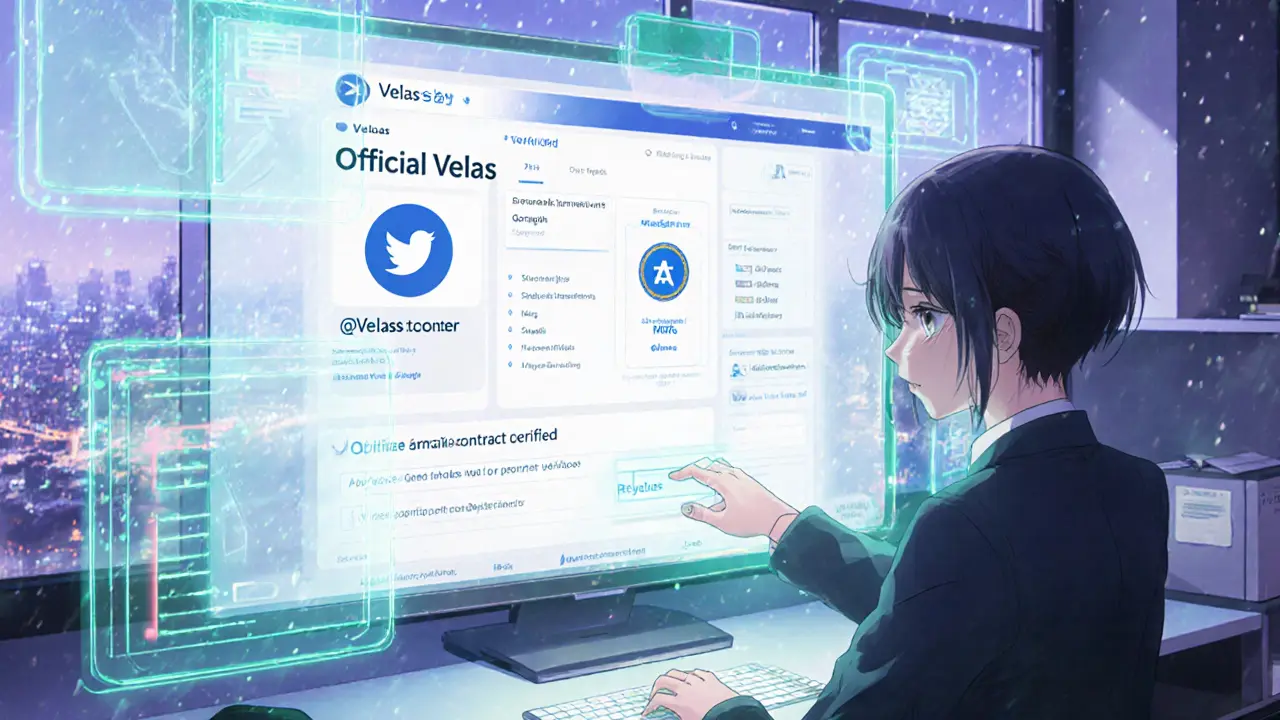Velas Airdrop Verification Checker
Verify Airdrop Legitimacy
Check if a claimed Velas GRAND airdrop is legitimate by verifying key security indicators.
When you hear about a new Velas GRAND airdrop, the first reaction is usually excitement - free tokens sound too good to miss. But excitement can turn into a headache if you’re not sure whether the giveaway is legit or if you’re missing a step. This guide breaks down everything you need to know about the rumored Velas GRAND airdrop, walks you through a safe claim process, and shows how to spot fake offers before you hand over any personal info.
What the "GRAND" Airdrop Claims to Be
Velas is a high‑throughput blockchain that uses a hybrid consensus model (Proof‑of‑History + Delegated Proof‑of‑Stake) to process thousands of transactions per second. Its native token, VLX, powers staking, governance, and fee payments on the network. According to circulating rumors, the "GRAND" airdrop is meant to reward existing VLX holders with a bonus token that will be distributed in a single, large‑scale event.
Official Velas channels have not published a dedicated blog post or announcement confirming a "GRAND" airdrop as of October 2025. That gap is why many community members are asking the same questions: when does it start, how many tokens are on offer, and which wallets are eligible?
How to Verify Whether the Airdrop Is Real
Before you click any link, follow these three verification steps:
- Check the official Velas communication channels. The most reliable sources are the Velas website (velas.com), the Velas Twitter account, and the Velas Telegram groups. Look for a post that mentions "GRAND airdrop" together with a date, eligibility criteria, and a claim URL that uses the velas.com domain.
- Cross‑reference the announcement with reputable crypto news sites. Outlets like CoinDesk, The Block, and CryptoSlate typically publish summaries of major airdrops. If none of them have covered the GRAND airdrop, treat the claim with caution.
- Inspect the smart contract address. A legitimate airdrop will publish the contract address on the official site. Use a block explorer (e.g., explorer.velas.com) to verify that the contract is verified, has a clear token name (often ending in "GRAND"), and shows a distribution transaction matching the announced total supply.
Step‑by‑Step: How to Claim a Legitimate Velas Airdrop
Assuming you’ve confirmed the airdrop’s authenticity, here’s the safest way to claim your tokens.
- Prepare a compatible wallet. The Velas ecosystem supports MetaMask (configured for the Velas network), Trust Wallet, and the native Velas App. Make sure you have the latest version installed.
- Add the Velas network to your wallet. For MetaMask, go to Settings → Networks → Add Network and paste the following RPC details:
- Network Name: Velas Mainnet
- New RPC URL: https://evmexplorer.velas.com/rpc
- Chain ID: 106
- Currency Symbol: VLX
- Connect your wallet to the official claim portal. The portal URL will be something like
https://airdrop.velas.com. Click "Connect Wallet" and approve the connection in your wallet extension. - Enter your VLX holding address. The airdrop contract typically reads your balance automatically, but some claims require you to paste the address that holds VLX at the snapshot date.
- Confirm the claim transaction. You’ll see a small gas fee (usually a fraction of a cent on Velas). Approve the transaction and wait for the confirmation message.
- Verify receipt. After the transaction is confirmed, add the new token contract address to your wallet’s custom token list. You should see the GRAND token balance appear instantly.

Red Flags - How to Spot a Fake Velas Airdrop
Scammers love to mimic big‑name projects. Below is a quick side‑by‑side comparison that helps you differentiate a real Velas giveaway from a phishing trap.
| Aspect | Legitimate Velas Airdrop | Typical Scam |
|---|---|---|
| Domain | Official velas.com sub‑domain (e.g., airdrop.velas.com) | Random .com, .xyz, or URL shorteners |
| Announcement Source | Verified Twitter @Velas, official blog, Telegram | Anonymous Reddit post, DM on Discord |
| Smart Contract Verification | Verified source code on Velas Explorer | Unverified or hidden contract address |
| Fee Requirement | Minimal network gas (covered by Velas’s low fees) | Requests large fees, “donations,” or private keys |
| User Data Request | Only wallet address needed | Requests email, ID, or private key |
Safety Checklist Before You Click Anything
- Is the URL exactly
https://airdrop.velas.com(or another verified sub‑domain)? - Does the page display the Velas logo and a clear disclaimer about no private‑key sharing?
- Have you cross‑checked the announcement on at least two official channels?
- Did you inspect the contract address on the Velas block explorer?
- Are you only being asked to approve a transaction in your wallet - never to send funds to an external address?
What to Do If You’ve Already Fell for a Scam
Unfortunately, a few users report losing access to their wallets after entering private keys on a fake “GRAND airdrop” site. If that’s you, act fast:
- Revoke the compromised address. Use a service like revoke.cash to cut off any token approvals tied to the malicious contract.
- Move remaining assets. Transfer any untouched VLX or other tokens to a brand‑new wallet that has never been exposed.
- Report the phishing site. File a report with the Velas community on Telegram and with the relevant platform (e.g., Twitter, Google Safe Browsing).
- Consider a hardware wallet. For long‑term security, store VLX on a Ledger or Trezor device.
Frequently Asked Questions
Is the Velas GRAND airdrop officially announced?
As of mid‑October 2025, Velas has not posted a formal announcement about a "GRAND" airdrop on its website, Twitter, or Telegram. Always verify any claim against these official sources before proceeding.
Do I need to pay a fee to receive the airdrop?
A legitimate Velas airdrop only requires the tiny network gas fee needed to submit the claim transaction. Any request for large payments, donations, or private‑key sharing is a red flag.
Which wallets can I use to claim?
MetaMask (configured for Velas), Trust Wallet, and the official Velas App all support the claim process. Make sure you are using the latest version of the wallet.
How can I confirm the smart contract is safe?
Open the contract address on Velas Explorer. Look for a "Verified Contract" badge and check that the source code matches the description in the official announcement.
What should I do if I entered my private key on a fake site?
Immediately revoke token approvals, move any remaining funds to a new wallet, and report the phishing URL to Velas’s community channels. Using a hardware wallet for future holdings can prevent repeat incidents.



DeAnna Greenhaw
July 20, 2025 AT 11:26One must first acknowledge the gravitas of the Velas ecosystem before embarking upon any airdrop; its hybrid consensus is nothing short of a marvel of modern cryptographic engineering. Thus, any purported “GRAND” distribution should be scrutinized against the official channels with the same rigor one applies to a fine wine tasting.
Luke L
July 22, 2025 AT 19:00Anyone on US soil who blindly clicks these links is practically handing their wallets to foreign scammers.
Cynthia Chiang
July 25, 2025 AT 02:33Hey folks, I just wanted to drop a quick note that if you’ve already taken a peek at the Velas news feed, you’ll notice there’s absolutely no mention of a “GRAND” drop as of now – keep an eye on their Twitter and the official blog, they usually post a clear banner when something big is coming. Also, double‑check the URL you’re about to visit; the legit site always starts with https://airdrop.velas.com and never a random .xyz or a shortened link. If you’re ever in doubt, pause and ask a friend who’s more experienced – better safe than sorry!
Hari Chamlagai
August 1, 2025 AT 01:13The phenomenon of speculative airdrops, especially on high‑throughput platforms such as Velas, invites a deeper examination of collective rationality.
When participants chase ill‑fated promises, they often overlook the fundamental principle that value is derived from verifiable utility, not hype.
The first safeguard, therefore, is to anchor one's actions in the immutable ledger, confirming that any contract address is marked as verified on the explorer.
A verified contract bears a badge, a public source code, and a transaction history that aligns with the announced token supply, providing a cryptographic proof of legitimacy.
Secondly, the community must interrogate the source of the announcement; a tweet from the official @Velas handle carries far more weight than an anonymous Reddit post.
If the message originates from an unofficial channel, the probability of deception rises exponentially, a fact that is empirically supported by numerous phishing case studies.
Moreover, the gas fee required for a legitimate claim on Velas is minuscule, often a fraction of a cent, because the network’s design minimizes transaction costs.
Any demand for an upfront payment, donation, or private‑key disclosure is a categorical red flag that no rational actor should ignore.
The psychological lure of free tokens exploits loss aversion, but disciplined investors recognize that the only cost they should incur is the unavoidable network fee.
In practice, I advise configuring MetaMask with the correct RPC details and adding the contract address manually to avoid any spoofed interface that could exfiltrate credentials.
After initiating the claim, monitor the transaction hash on the explorer; a single confirmation is sufficient to see the new token appear in your wallet.
Should the token fail to materialize, it is prudent to revoke any approvals granted to the contract via services like revoke.cash, thereby neutering any lingering permissions.
Finally, maintain a security‑first mindset: store the bulk of your holdings in a hardware wallet, and treat any airdrop claim as a temporary, low‑value interaction.
By adhering to these systematic steps, you transform a potentially hazardous scenario into a disciplined exercise in blockchain hygiene.
Remember, the true reward lies not in the free tokens themselves, but in the confidence you gain by mastering the verification process.
Ben Johnson
August 3, 2025 AT 08:46Looks like someone just turned a common‑sense warning into an anthem-nice work, but let’s keep the drama down and actually check the tweet thread before calling it a scam.
Jason Clark
August 5, 2025 AT 16:20Pro tip: if you’re hunting for the contract address, head straight to explorer.velas.com, paste the alleged address, and make sure the “Verified Contract” badge is flashing-if it’s not, the airdrop is probably as fake as a Kardashian selfie.
Scott G
August 7, 2025 AT 23:53I concur with the previous recommendation; verifying the contract on the official explorer constitutes a primary safeguard, and employing a hardware wallet for subsequent storage further mitigates exposure to malicious actors.
VEL MURUGAN
August 10, 2025 AT 07:26All right, friends, the safety checklist you’ve been handed is solid gold-double‑check that URL, verify the logo, and never, ever send private keys. Follow those steps and you’ll stay out of the phishing swamp.